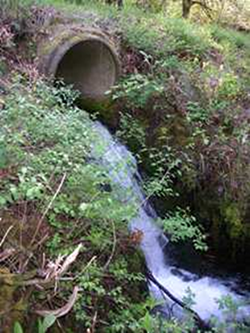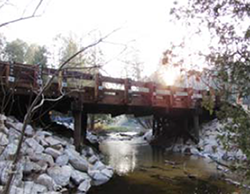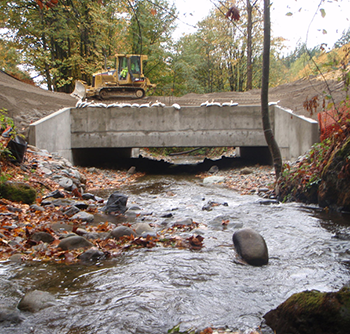|
Culverts, dikes, and dams are common fixtures throughout the Nation's transportation infrastructure. They help to prevent flooding, generate electricity, and support healthy drinking water supplies while allowing for roadway and rail transportation over streams and rivers. Though effective at performing these primary functions, these crossings can present barriers to the movement of fish and other aquatic species. Habitat fragmentation and degradation caused by these barriers has resulted in severe habitat reduction and even near extinction of some fish populations. An estimated six million barriers exist nationwide, many of which are now obsolete and could be removed without impacting local transportation.
National and State agencies, including the U.S. Fish and Wildlife Service (USFWS) and the Washington State Department of Transportation (WSDOT), have developed programs to conserve and restore local aquatic resources by removing or modifying out-of-date waterway crossings through stand-alone barrier removal initiatives and also as part of larger transportation projects. By reconnecting streams and rivers, these programs increase habitat connectivity and create healthier aquatic environments for fish. Programs to promote fish passage can also improve water quality and sediment management, increase biodiversity, and help protect the dwindling populations of freshwater species. In addition to ecosystem benefits, these programs can yield local community benefits by restoring and enhancing sport fishing, boating, and wildlife viewing opportunities, as well as respecting the cultural values ascribed to many waterways.

This culvert is a barrier to fish passage because its opening is too high for fish to jump into, preventing them from reaching their upstream habitat. (Courtesy of WSDOT)
National Fish Passage Program
Launched in 1999 by USFWS, the National Fish Passage Program (NFPP) is a voluntary initiative that provides funding and technical assistance to local communities to restore free-flowing rivers by removing or bypassing artificial barriers to fish movement. Program participants can include Federal, State, and local government agencies; nonprofit organizations; small businesses; private landowners; and universities. To date, the NFPP has supported the removal of approximately 1,340 fish passage barriers, reopening access to more than 20,000 stream miles, reconnecting over 155,000 acres of wetlands, and benefitting over 90 fish and other aquatic species.
To participate in the program, interested organizations submit a project proposal to their local Fish and Wildlife Conservation Office that identifies the need, objective, methods, and anticipated results of the project. For example, proposals may include the estimated river miles or acres opened up by the project and the anticipated benefits that the project provides to specific local species. The applicable local and regional Fish and Wildlife Conservation Offices review and prioritize the project proposals based on expected ecological benefits, the permanence of the fish passage improvements, and evidence of public support for the project.
In addition to providing funds and technical expertise to remove fish barriers, the NFPP also creates economic benefits for the communities with which it partners. Since 1999, the NFPP has generated an economic value of more than $11 billion for local communities through job creation, reduced maintenance costs, and increased eco-tourism and outdoor recreation.
The Black River Crossing at Sucker Creek Road is an example of a fish passage project that used NFPP funds to improve ecosystem quality and habitat connectivity.
Black River Crossing at Sucker Creek Road
The Great Lakes Fishery Trust identified a barrier to fish passage where Sucker Creek Road crosses the Black River in northeast Michigan. The narrow, undersized culverts at the crossing blocked the passage of fish and other aquatic species. The culverts also impacted natural stream processes, causing stream bank erosion downstream and increasing sediment deposits into the watershed.

A 30-foot timber bridge replaced the culverts that once spanned the Black River. (Courtesy of USFWS)
In partnership with the U.S. Forest Service and Huron Pines, a nonprofit conservation organization, and with funding from the NFPP, the Great Lakes Fishery Trust removed the old culverts and replaced them with a 30-foot timber bridge. The new bridge provides unrestricted passage to all aquatic species in the ecosystem, including migratory species like brook trout, which seasonally move upstream from Lake Huron. Migratory fish now have access to an additional 28 river miles of spawning, nursery, and feeding habitat. The uninterrupted river flow provided by the bridge also improves the river's ability to transport sediment.
WSDOT's Fish Passage Barrier Removal Program
Washington State's Fish Passage Barrier Removal Program identifies and removes barriers to fish passage caused by culverts under State highways. WSDOT uses funds from its Highway Construction Program to contract with the Washington Department of Fish and Wildlife (WDFW) to regularly inventory existing river crossings. WDFW evaluates fish passability at all fish-bearing stream crossings and conducts physical habitat surveys upstream from the crossings. WSDOT and WDFW use this information to prioritize culvert removal projects that provide the largest habitat gains. WDFW has inventoried over 6,500 stream crossings statewide, revealing nearly 2,000 barriers to fish passage. The agency determined that over 1,500 of these WSDOT-owned fish passage barriers would generate significant habitat gain if WSDOT modified or replaced them.
WSDOT takes three approaches to passage improvements: removing barriers as a part of larger highway projects, addressing high-priority barriers through stand-alone projects, and correcting some barriers through the State's culvert maintenance program, which repairs or replaces failing culverts. The majority of the barrier removal projects are components of larger roadway projects. When improving fish passages, WSDOT and WDFW work together to identify culvert designs that reflect the natural conditions found at the site. For example, the agencies install “stream simulations,” crossings that are designed to simulate natural streambeds.

Natural streambed material underneath the East Fork Issaquah Creek culvert simulates nearby stream conditions. (Courtesy of WSDOT)
Since 1991, WSDOT has completed 269 fish barrier removal projects using these three approaches, improving passage to over 904 miles of upstream fish habitat. The agency will undertake an additional 23 barrier correction projects in 2013. The East Fork Issaquah Creek Fish Passage project, described below, is an example of one such project that WSDOT and WDFW have completed.
East Fork Issaquah Creek Fish Passage
In 2006, WDFW identified a culvert that acted as a fish barrier near the Interstate 90 crossing of the east fork of Issaquah Creek. Issaquah Creek is home to sockeye, chinook, and coho salmon as well as steelhead, sea-run cutthroat, and resident trout. This 12-foot-wide culvert restricted the stream's flow, increasing water velocity. The rapid water speed exceeded the swimming capacity of the fish, which prevented salmon and trout from accessing rearing and spawning grounds upstream. In close vicinity to the culvert, deteriorated weirs, river barriers similar to dams, altered the flow of the waterway. The downstream weirs produced a 1.8-foot drop in the stream, too high for the fish to leap.
WSDOT and WDFW evaluated possible alternatives for improving the passability of the waterway for fish, and the agencies chose to replace the existing culvert with a 40-foot-wide culvert that mimics the natural conditions of the site and does not accelerate the velocity of the water. WSDOT also removed the deteriorated downstream weirs and replaced them with several shorter ones that allow for fish passage. Completed in 2012 as a stand-alone barrier removal project, the new culvert and weirs provide improved stream flow along the Issaquah Creek and allow fish to migrate to their former spawning grounds.
Resources to Reduce the Impacts of Fish Passage Barriers
Both the NFPP and WSDOT's Fish Passage Barrier Removal Program help to improve fish passage through the removal or modification of barriers. In 2003, WDFW developed the manual, Design of Road Culverts for Fish Passage, to help WSDOT and other agencies identify the best alternative for correcting fish passage problems. Maine and California have used the manual as a model for developing their own guidance documents on road culvert design. Also, USFWS created the Geospatial Fisheries Information Network (GeoFIN) to assist biologists and the general public with identifying and evaluating significant fish passage barriers across the country. GeoFIN is a web-based application that includes a centralized database of fish passage barriers and analytical tools to support fish passage conservation efforts. USFWS also partnered with the University of Massachusetts Amherst to develop the only fish passage engineering graduate degree program in the Nation, which combines hydrology, ecology, and biology to evaluate fishway design, barrier removal, and stream restoration. These resources are helping agencies across the country to improve fish passage, conserve aquatic resources, and restore free-flowing rivers while yielding significant community benefits.
Look What's New!
- FHWA recently released a brand-new version of the Section 4(f) Tutorial, an online resource that is designed to help transportation professionals and other interested individuals understand the fundamental requirements of Section 4(f). The interactive website covers ten subjects relating to the application of Section 4(f) and includes several project examples to help illustrate the principles of the provision.
|

